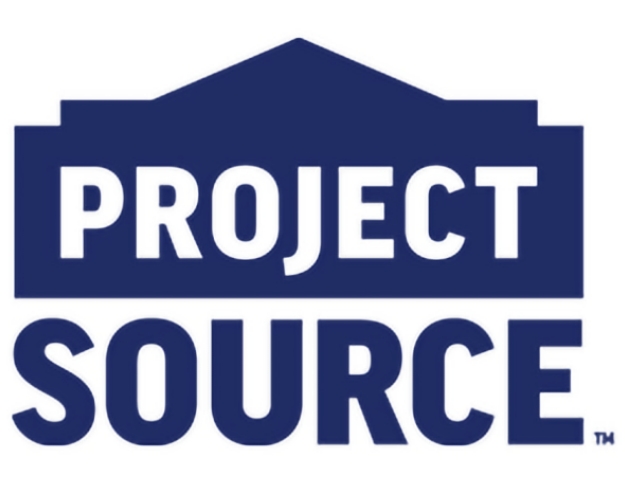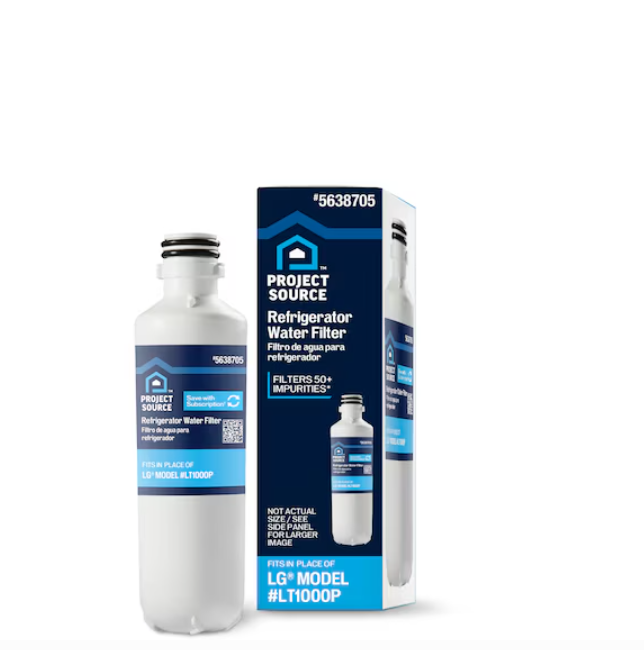
Project Source Twist-in Refrigerator Water Filter Fits LG Filter LT1000P
- Filters 50 Plus Impurities Including: Lead, Asbestos, Mercury, Chlorine Taste and Odor, 8 Pharmaceuticals, and Cysts; for complete list, see performance data sheet for full contaminant reduction information
- Certified by IAPMO R and T against CSA B483.1, NSF/ANSI 372 for low lead content, NSF P473, NSF/ANSI Standard 42, 53 and 401 for the reduction of claims specified on the performance data sheet
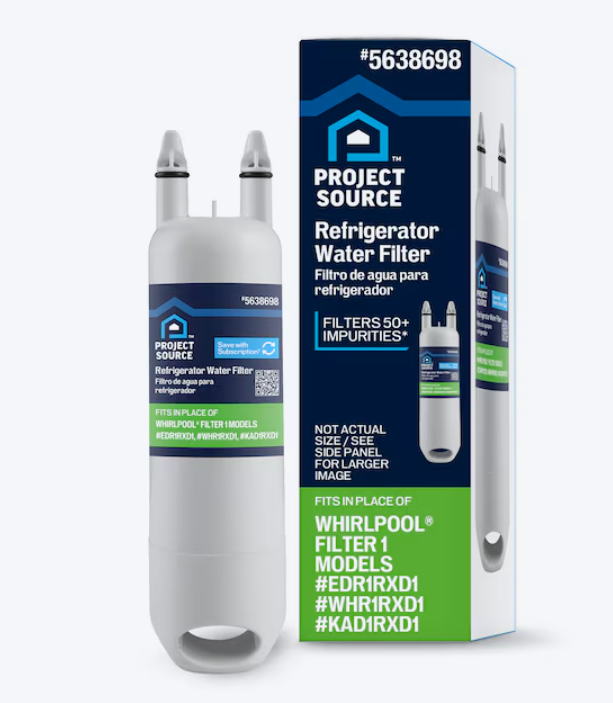
Project Source Push-in Refrigerator Water Filter Fits Whirlpool EDR1RXD1
- Filters 50 Plus Impurities Including: Lead, Asbestos, Mercury, Chlorine Taste and Odor, 8 Pharmaceuticals, and Cysts; for complete list, see performance data sheet for full contaminant reduction information
- Certified by IAPMO R and T against CSA B483.1, NSF/ANSI 372 for low lead content, NSF P473, NSF/ANSI Standard 42, 53 and 401 for the reduction of claims specified on the performance data sheet
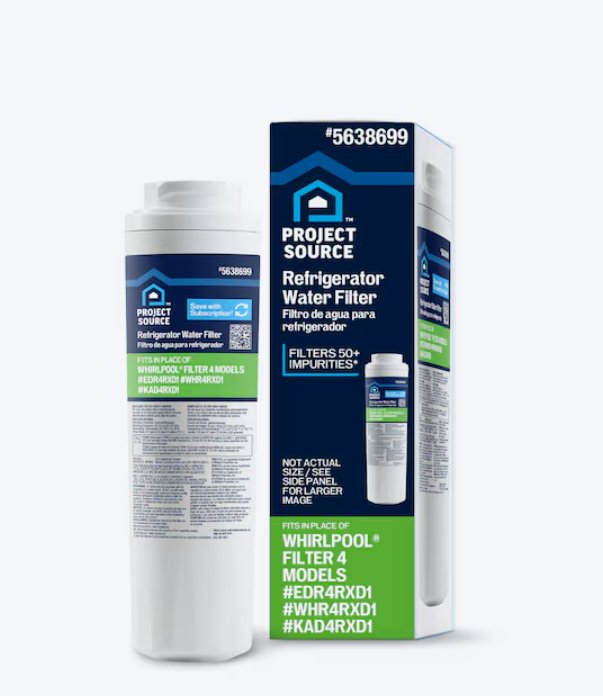
Project Source Twist-in Refrigerator Water Filter Fits Whirlpool EDR4RXD1
- Filters 50 Plus Impurities Including: Lead, Asbestos, Mercury, Chlorine Taste and Odor, 8 Pharmaceuticals, and Cysts; for complete list, see performance data sheet for full contaminant reduction information
- Certified by IAPMO R and T against CSA B483.1, NSF/ANSI 372 for low lead content, NSF P473, NSF/ANSI Standard 42, 53 and 401 for the reduction of claims specified on the performance data sheet
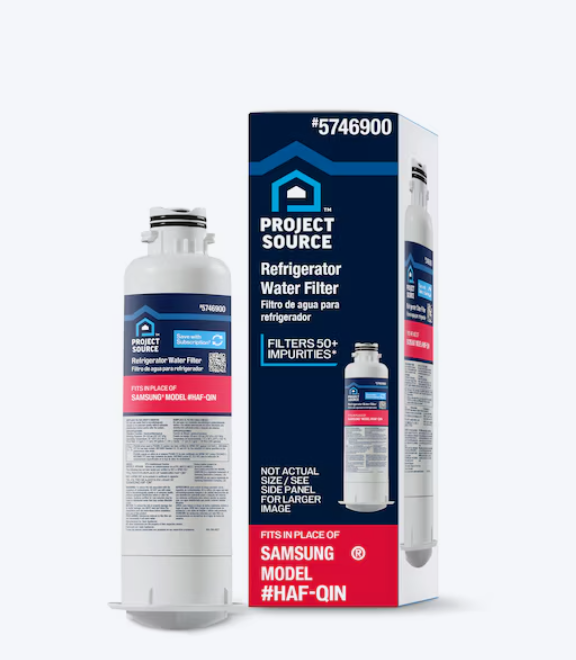
Project Source Push-in Refrigerator Water Filter Fits Samsung HAF-QIN
- Filters 50 Plus Impurities Including: Lead, Asbestos, Mercury, Chlorine Taste and Odor, 8 Pharmaceuticals, and Cysts; for complete list, see performance data sheet for full contaminant reduction information
- Certified by IAPMO R and T against CSA B483.1, NSF/ANSI 372 for low lead content, NSF P473, NSF/ANSI Standard 42, 53 and 401 for the reduction of claims specified on the performance data sheet
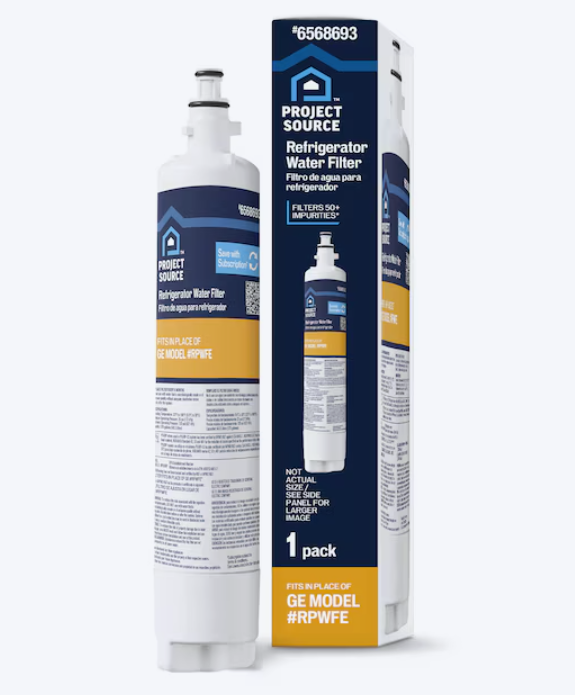
Project Source Twist-in Refrigerator Water Filter Fits GE Filter RPWFE
- Filters 50 Plus Impurities Including: Lead, Asbestos, Mercury, Chlorine Taste and Odor, 8 Pharmaceuticals, and Cysts; for complete list, see performance data sheet for full contaminant reduction information
- Certified by IAPMO R and T against CSA B483.1, NSF/ANSI 372 for low lead content, NSF P473, NSF/ANSI Standard 42, 53 and 401 for the reduction of claims specified on the performance data sheet
Transforming Your Tap Water into a Healthier, Tastier Experience
Water—the essence of life itself. We drink it, cook with it, bathe in it, and yet many of us pay little attention to its quality until something seems off. That slight chlorine smell, the occasional sediment, or that indefinable “tap water taste” can make even the most hydration-conscious among us reach for bottled alternatives. But what if there was a simple, cost-effective solution that transforms your ordinary tap water into something extraordinary? Enter the world of Project Source water filters.
As someone who has spent years researching home improvement products, I’ve seen countless water filtration systems come and go. Some promise the moon but deliver mere pebbles, while others operate with quiet efficiency, improving our daily lives without fanfare. Project Source water filters fall firmly into the latter category—offering remarkable water purification without breaking the bank or requiring an engineering degree to install.
In this comprehensive guide, we’ll dive deep into everything you need to know about Project Source water filters—from the basic functionality to installation tips, maintenance requirements, and how they stack up against competitors. Whether you’re a first-time filter buyer or looking to upgrade your current system, this article aims to quench your thirst for knowledge.
What Exactly Is a Project Source Water Filter?
Before we dive into the specifics, let’s clarify what we’re talking about. Project Source is a home improvement brand primarily sold through Lowe’s stores. Their water filtration line includes various products designed to improve water quality by removing contaminants, reducing unpleasant tastes and odors, and delivering cleaner water straight from your tap.
These filters aren’t just about making water taste better (though they certainly do that). They’re about providing an additional layer of protection between your municipal water supply and your glass. While U.S. tap water is generally safe to drink, many people prefer filtered water due to concerns about aging infrastructure, regional water quality issues, or simply personal preference for better-tasting water.
Project Source offers solutions ranging from simple faucet-mounted filters to under-sink systems, each designed to address different filtration needs and installation preferences. What makes them particularly attractive to homeowners is their balance of effectiveness, affordability, and user-friendliness.
The Science Behind the Sip: How Project Source Water Filters Work
Understanding how these filters work helps appreciate what you’re getting. At their core, Project Source water filters utilize several filtration technologies working in harmony:
- Mechanical filtration: The first line of defense captures larger particles like sediment, rust, and other visible contaminants. Think of this as a microscopic sieve that keeps the chunky stuff out of your glass.
- Activated carbon: This is where the magic happens for taste and odor. Activated carbon works through adsorption—a process where contaminants are attracted to and bind to the carbon surface. This is particularly effective at removing chlorine, which is commonly used in municipal water treatment and responsible for that “pool water” smell and taste many people dislike.
- Ion exchange media: Some Project Source filters include materials that swap unwanted ions (like lead or copper that might leach from old plumbing) with harmless ones, reducing heavy metal content in your water.
When water enters the filter, it passes through these various stages, emerging noticeably improved in both taste and purity. The beauty of the system lies in its simplicity—water pressure does all the work, pushing water through the filtration media without requiring electricity or complex mechanisms.
The result? Water that tastes cleaner and fresher, with reduced levels of common contaminants that might affect taste, odor, or potentially even health.
Project Source Filter Options: Finding Your Perfect Match
Not all water filters are created equal, and Project Source offers several types to meet different needs. Here’s a breakdown of their main offerings:
Faucet-Mounted Filters
These attach directly to your existing faucet, offering the ultimate in convenience and simplicity. Installation takes minutes, requires no tools, and provides immediate filtered water. They typically feature a bypass valve that lets you switch between filtered and unfiltered water (unfiltered is better for washing dishes, for example, as it conserves filter life).
Faucet-mounted filters are ideal for renters or those wanting to try water filtration without committing to a permanent installation. They’re also the most affordable entry point into the Project Source lineup, with prices typically ranging from $15-30 depending on the model and filtration capabilities.
The drawback? They’re visible on your faucet and may not fit all faucet designs. Some users also find they slightly reduce water pressure compared to unfiltered flow.
Under-Sink Systems
For those seeking a more discreet solution with higher capacity, Project Source offers under-sink filtration systems. These install beneath your sink cabinet and connect directly to your cold water line. Many models come with a dedicated filtered water faucet that installs alongside your existing faucet.
The advantages here include greater filtration capacity (meaning less frequent filter changes), no visible equipment cluttering your sink area, and often more advanced filtration capabilities. These systems typically range from $60-150 for the initial setup, with replacement filters costing around $20-40 depending on the model.
Installation is more involved than faucet-mounted options but still manageable for moderately handy homeowners. Most kits come with detailed instructions and all necessary hardware.
Pitcher Filters
While less common in the Project Source lineup, they do offer some water filter pitchers that work by gravity—you fill the top reservoir, and water gradually drips through the filter into the main pitcher below. These are the ultimate in portability and require no installation whatsoever.
Pitcher filters are perfect for those who rent, move frequently, or want to filter small quantities of drinking water without modifying plumbing. They’re also the most budget-friendly option, with complete pitchers typically costing $20-35 and replacement filters around $10-15.
The main limitations? You need to refill them manually, they filter relatively small amounts of water at a time, and they take up refrigerator space if you prefer cold water.
Contaminant Removal: What Project Source Filters Tackle
One of the most common questions about any water filter is simple: “What does it actually remove?” Project Source filters vary by model, but most address these common concerns:
• Chlorine: Nearly all Project Source filters effectively reduce chlorine, which improves both taste and odor significantly. This is often the most noticeable immediate benefit.
• Sediment and particulates: From rust particles to sand and silt, mechanical filtration removes visible particulates that might make water appear cloudy or contain small specks.
• Heavy metals: Many (though not all) Project Source filters reduce common metals like lead and copper that might leach from aging pipes. The more advanced models typically offer better performance in this area.
• Volatile organic compounds (VOCs): Some models reduce these chemicals, which can enter water supplies from industrial processes, agricultural runoff, or gasoline.
• Certain microorganisms: While not designed as purifiers, some filters can reduce certain microorganisms. However, if microbial contamination is your primary concern, you’ll want to verify the specific capabilities of your chosen model.
It’s important to note that no consumer-grade filter removes everything. Project Source filters are designed to improve municipal water that’s already treated and generally safe to drink. They’re not intended to make unsafe water (like from untreated natural sources) potable.
For those with specific contamination concerns, always check the filter’s specifications to ensure it addresses your particular needs. Some regions have unique water quality challenges that might require more specialized filtration.
The Installation Experience: Getting Your Filter Up and Running
One of the selling points of Project Source filters is their user-friendly installation. Here’s what to expect with the different types:
Faucet-Mounted Installation
- Remove the aerator from your faucet (the small screen at the tip)
- Select the appropriate adapter from those provided in the kit
- Screw the filter assembly onto your faucet
- Run cold water through the filter for 5-10 minutes to activate the carbon
- You’re done!
The entire process typically takes less than 10 minutes, requires no tools, and can be reversed just as easily. Most models fit standard faucets, but some decorative or pull-out faucets may not be compatible.
Under-Sink Installation
- Shut off the cold water supply valve under your sink
- Install the water supply line adapter to divert water to the filter
- Mount the filter housing to the cabinet wall (typically using screws)
- Connect the water lines according to the labeled inlet and outlet
- If your system includes a dedicated faucet, drill a hole in your sink or countertop (unless there’s an existing soap dispenser or sprayer hole you can use)
- Install the faucet and connect it to the filter output
- Turn the water back on and check for leaks
- Flush the system according to manufacturer instructions
This installation is more involved, typically taking 1-2 hours for someone with basic DIY skills. Most kits include all necessary hardware, though you may need basic tools like a wrench, screwdriver, and possibly a drill.
For those uncomfortable with plumbing work, this is a job that most handymen or plumbers can complete quickly for a reasonable fee. The investment might be worthwhile for the peace of mind and professional installation.
Maintenance: Keeping Your Filter in Prime Condition
No filter lasts forever. The filtration media eventually becomes saturated with contaminants, reducing effectiveness and potentially affecting water flow. Here’s what to know about maintaining your Project Source filter:
Replacement Schedule
Most Project Source faucet filters need replacement every 2-3 months or after filtering approximately 100-200 gallons of water (depending on the model). Under-sink filters typically last longer—around 6 months or 500-600 gallons.
Many models include indicator lights or tracking features that help you monitor filter life. These may be based on time, water volume, or flow characteristics that change as the filter becomes saturated.
Signs Your Filter Needs Replacement
Even without indicators, your water will tell you when the filter is nearing the end of its useful life:
• Noticeably slower water flow
• Return of chlorine taste or odor
• Visible particles in the water
• Changes in water clarity
Don’t wait until water quality noticeably degrades—by then, you’re drinking water through a filter that’s no longer doing its job effectively.
Cleaning and Maintenance
Beyond replacing the filter cartridge itself, some basic maintenance helps ensure optimal performance:
• Wipe down the exterior of faucet-mounted filters regularly to prevent mineral buildup
• For under-sink systems, check connections periodically for any slow leaks
• Follow manufacturer instructions for any system flushing procedures when replacing filters
Most Project Source filters don’t require extensive maintenance beyond timely cartridge replacement—a significant advantage over more complex systems.
The Investment: Understanding Project Source Filter Costs
Water filtration is an ongoing investment, not a one-time purchase. Here’s what to expect cost-wise:
Initial Purchase
• Faucet-mounted filters: $15-30
• Under-sink systems: $60-150
• Pitcher filters: $20-35
Ongoing Costs
• Faucet filter replacements: $10-20 every 2-3 months
• Under-sink replacements: $20-40 every 6 months
• Pitcher filter replacements: $10-15 every 1-2 months
When calculating the true cost, consider your household water usage. A family of four will need more frequent replacements than a single person or couple.
For perspective, even with regular filter replacements, a Project Source system typically costs less than bottled water for the same volume. A family spending $20 weekly on bottled water ($1,040 annually) might spend just $150-300 annually on a maintained filtration system.
Performance in Real-World Conditions: What to Expect
Marketing materials paint an idyllic picture of perfect water, but what can you realistically expect from a Project Source filter in day-to-day use?
Taste and Odor Improvement
This is where Project Source filters truly shine. Most users notice an immediate improvement in taste and smell, particularly if their municipal water is heavily chlorinated. The difference is often dramatic enough that many find themselves drinking more water and using less flavoring (like tea bags or coffee grounds) to achieve the same taste intensity.
Flow Rate Considerations
All filters create some resistance to water flow. Project Source models aim to balance filtration effectiveness with practical flow rates, but you will notice some reduction compared to unfiltered water—typically around 20-30% for faucet models and somewhat less for under-sink systems.
For most kitchen uses, this reduction is acceptable, but it might be frustrating if you’re filling large pots or have very low water pressure to begin with.
Compatibility Challenges
While Project Source designs their products for broad compatibility, some fixtures present challenges:
• Faucet-mounted filters don’t work with pull-out or spray faucets
• Some designer faucets have unusual threading that doesn’t match standard adapters
• Under-sink systems require adequate cabinet space for installation
Before purchasing, measure your space and check your faucet compatibility to avoid disappointment.
Project Source vs. Competitors: How Do They Stack Up?
The water filtration market is crowded with options, from budget brands to premium systems costing hundreds or even thousands of dollars. Here’s how Project Source compares to key competitors:
Vs. Brita and PUR
These well-known brands compete directly with Project Source in the affordable filtration segment. The performance is generally comparable across similar product types, with all three effectively reducing chlorine and improving taste.
Price points are similar, though Project Source often offers slightly lower costs on both initial purchase and replacement filters. The main difference lies in availability—Brita and PUR are sold virtually everywhere, while Project Source is primarily available through Lowe’s.
Vs. Premium Brands (Culligan, Aquasana, etc.)
Higher-end filtration systems typically offer more comprehensive contaminant removal and longer filter life. They may reduce a broader spectrum of contaminants, including some that Project Source doesn’t address effectively.
However, this performance comes at a significant price premium—often 3-5 times the cost of comparable Project Source products. For most households using treated municipal water, this additional capability may not justify the extra expense.
Vs. Reverse Osmosis Systems
Reverse osmosis (RO) systems represent the high end of consumer water filtration, removing virtually all contaminants including dissolved minerals. They’re substantially more expensive and complex than Project Source filters, typically costing $200-500 initially with more involved maintenance.
While RO systems produce exceptionally pure water, they also waste water in the process (creating several gallons of waste for each gallon filtered) and remove beneficial minerals along with contaminants. For most households, Project Source filters strike a more practical balance of performance, price, and environmental impact.
Environmental Considerations: The Eco-Friendly Angle
Water filtration inherently has environmental implications—both positive and negative. Here’s the Project Source environmental profile:
Positive Environmental Impact
• Reduces plastic waste from bottled water consumption
• Lowers carbon footprint compared to producing, shipping, and recycling bottled water
• Encourages tap water consumption, supporting public water infrastructure
Environmental Challenges
• Filter cartridges create waste, as most cannot be recycled through conventional programs
• Manufacturing and shipping new filters has an environmental footprint
• Some models use plastic components that aren’t biodegradable
On balance, home water filtration generally represents an environmental improvement over bottled water consumption, but falls short of the lowest-impact option: drinking unfiltered tap water from reusable containers. For those concerned about minimizing environmental impact, look for Project Source models with the longest cartridge life to reduce replacement frequency.
Special Considerations: Well Water and Specific Contaminants
While Project Source filters are primarily designed for municipal water, many customers wonder about their effectiveness with well water or specific contaminant concerns.
Well Water Compatibility
Project Source filters can improve the taste and odor of well water and remove some sediment, but they’re not designed to address all common well water issues:
• They won’t effectively treat bacterial contamination
• They’re not designed to handle high levels of iron or sulfur
• They don’t address water hardness issues
If you’re on well water with specific known contamination issues, you’ll likely need a more specialized filtration system designed for your particular water profile.
Regional Water Concerns
Different regions face different water challenges. Project Source filters address common nationwide concerns but may not target region-specific issues:
• Hard water regions: Project Source filters don’t soften water or prevent mineral buildup
• Agricultural areas: Some pesticides and nitrates might require more specialized filtration
• Industrial regions: Certain industrial contaminants may need targeted removal systems
If you have concerns about specific contaminants in your local water supply, review your annual water quality report (available from your utility) and compare it with the removal capabilities of specific Project Source models.
The Warranty Question: What’s Covered and For How Long?
Project Source typically offers a limited warranty on their filtration products, though terms vary by model:
• Faucet-mounted filters: Usually 90 days to 1 year
• Under-sink systems: Typically 1-2 years on the housing, 30 days on filter cartridges
The warranty generally covers manufacturing defects but not issues resulting from improper installation, failure to replace filters on schedule, or damage from water conditions (like extreme hardness or sediment).
To maximize warranty protection:
- Keep your receipt
- Register the product if an option
- Follow all installation instructions precisely
- Maintain a filter replacement schedule
- Use only Project Source replacement cartridges
For specific warranty details, check the documentation included with your purchase or the Project Source website.
Practical Tips: Getting the Most From Your Project Source Filter
After helping numerous friends and family members with their water filtration setups, I’ve gathered some practical tips that can improve your experience:
Installation Wisdom
• Apply plumber’s tape to threaded connections to prevent leaks
• Hand-tighten fittings first, then use tools for the final quarter-turn
• Place a small bowl under connections when first turning water back on to catch any leaks
• Run cold water only through your filter—hot water reduces filter life and effectiveness
Maintenance Shortcuts
• Set calendar reminders for filter replacements
• Keep a spare filter cartridge on hand so you’re never caught without
• Label your filter with the installation date using a waterproof marker
• Consider subscribing to automatic filter delivery services if available
Usage Optimization
• For drinking and cooking, use filtered water
• For washing dishes or hands, unfiltered water preserves filter life
• Fill a pitcher for refrigeration rather than running filtered water until cold
• If your water sits unused for several days (like during vacation), run it for 30 seconds before using
Final Verdict: Is a Project Source Water Filter Right for You?
After exploring all aspects of Project Source water filters, we arrive at the fundamental question: should you buy one? The answer depends on your specific situation:
Project Source filters make the most sense if:
• You dislike the taste or smell of your tap water
• You currently buy bottled water and want a more economical, eco-friendly alternative
• You have minor concerns about potential contaminants in municipal water
• You’re seeking an affordable entry point into water filtration
• You shop at Lowe’s regularly and appreciate the convenience of their products
You might want to look elsewhere if:
• You have serious known contamination issues requiring specialized filtration
• You use well water with specific treatment needs
• You want the absolute highest level of filtration regardless of cost
• You need a system that addresses water hardness along with contaminant removal
For most households using municipal water, Project Source offers a sensible balance of performance, convenience, and affordability. The improvements in taste and odor alone justify the modest investment for many users, with potential health benefits serving as a welcome bonus.
The Bottom Line: Clean Water Made Simple
In a world where we’re constantly bombarded with expensive solutions to everyday problems, Project Source water filters stand out as refreshingly straightforward products that deliver genuine value without unnecessary complications or costs. They represent the sweet spot in home water filtration—effective enough to make a noticeable difference, affordable enough for most households, and simple enough for anyone to install and maintain.
Whether you’re taking your first step beyond tap water or looking to replace an existing filtration system, Project Source deserves consideration. Your taste buds—and possibly your health—will thank you for making the effort to improve what’s in your glass.
After all, few things are more fundamental to our daily lives than the water we consume. Investing in its quality is investing in your daily experience—one sip at a time.
